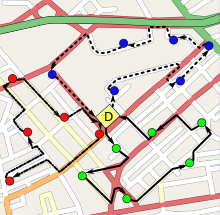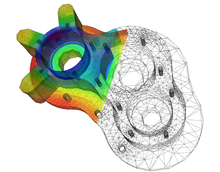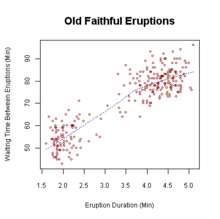Applied mathematics: Difference between revisions
| Line 68: | Line 68: | ||
{{Main|Mathematical economics}} |
{{Main|Mathematical economics}} |
||
Mathematical economics is the application of mathematical methods to represent theories and analyze problems in economic theory. By convention, the applied methods usually refer to nontrivial mathematical techinques or approaches. Mathematical economics is based on statistics & probability, mathematical programming, operations research, game theory and some methods from mathematical analysis. In this regard, it resembles (but is distinct from) [[financial mathematics]], another part of applied mathematics. |
Mathematical economics is the application of mathematical methods to represent theories and analyze problems in economic theory. By convention, the applied methods usually refer to nontrivial mathematical techinques or approaches. Mathematical economics is based on statistics & probability, mathematical programming (as well as other [[computational economics|computational methods]]), operations research, game theory, and some methods from mathematical analysis. In this regard, it resembles (but is distinct from) [[financial mathematics]], another part of applied mathematics. |
||
According to the [[Mathematics Subject Classification]] (MSC), mathematical economics falls into the [[Mathematics Subject Classification#Applied mathematics / other|Applied mathematics/other]] classification of category 91: |
According to the [[Mathematics Subject Classification]] (MSC), mathematical economics falls into the [[Mathematics Subject Classification#Applied mathematics / other|Applied mathematics/other]] classification of category 91: |
||
Revision as of 02:46, 22 July 2013

Applied mathematics is a branch of mathematics that concerns itself with mathematical methods that are typically used in science, engineering, business, and industry. Thus, "applied mathematics" is a mathematical science with specialized knowledge. The term "applied mathematics" also describes the professional specialty in which mathematicians work on practical problems; as a profession focused on practical problems, applied mathematics focuses on the formulation and study of mathematical models. In the past, practical applications have motivated the development of mathematical theories, which then became the subject of study in pure mathematics, where mathematics is developed primarily for its own sake. Thus, the activity of applied mathematics is vitally connected with research in pure mathematics.
History

Historically, applied mathematics consisted principally of applied analysis, most notably differential equations; approximation theory (broadly construed, to include representations, asymptotic methods, variational methods, and numerical analysis); and applied probability. These areas of mathematics were intimately tied to the development of Newtonian physics, and in fact the distinction between mathematicians and physicists was not sharply drawn before the mid-19th century. This history left a legacy as well: until the early 20th century subjects such as classical mechanics were often taught in applied mathematics departments at American universities rather than in physics departments, and fluid mechanics may still be taught in applied mathematics departments.[1] Engineering and computer science departments have traditionally made use of applied mathematics.
Divisions

Today, the term "applied mathematics" is used in a broader sense. It includes the classical areas above, as well as other areas that have become increasingly important in applications. Even fields such as number theory that are part of pure mathematics are now important in applications (such as cryptography), though they are not generally considered to be part of the field of applied mathematics per se. Sometimes, the term "applicable mathematics" is used to distinguish between the traditional applied mathematics that developed alongside physics and the many areas of mathematics that are applicable to real-world problems today.
There is no consensus as to what the various branches of applied mathematics are. Such categorizations are made difficult by the way mathematics and science change over time, and also by the way universities organize departments, courses, and degrees.
Many mathematicians distinguish between "applied mathematics", which is concerned with mathematical methods, and the "applications of mathematics" within science and engineering. A biologist using a population model and applying known mathematics would not be doing applied mathematics, but rather using it; however, mathematical biologists have posed problems that have stimulated the growth of pure mathematics. Mathematicians such as Poincaré and Arnold deny the existence of "applied mathematics" and claim that there are only "applications of mathematics"; similarly, non-mathematicians blend applied mathematics and applications of mathematics. The use and development of mathematics to solve industrial problems is also called "industrial mathematics".[2]
The success of modern numerical mathematical methods and software has led to the emergence of computational mathematics, computational science, and computational engineering, which use high-performance computing for the simulation of phenomena and the solution of problems in the sciences and engineering. These are often considered interdisciplinary disciplines.
Utility

Historically, mathematics was most important in the natural sciences and engineering. However, since World War II, fields outside of the physical sciences have spawned the creation of new areas of mathematics, such as game theory and social choice theory, which grew out of economic considerations, or neural networks, which arose out of the study of the brain in neuroscience.
The advent of the computer has created new applications: studying and using the new computer technology itself (computer science), using computers to study problems arising in other areas of science (computational science), and studying the mathematics of computation (for example, theoretical computer science, computer algebra, numerical analysis). Statistics is probably the most widespread mathematical science used in the social sciences, but other areas of mathematics are proving increasingly useful in these disciplines, most notably in economics.
Status in academic departments
Academic institutions are not consistent in the way they group and label courses, programs, and degrees in applied mathematics. At some schools, there is a single mathematics department, whereas others have separate departments for Applied Mathematics and (Pure) Mathematics. It is very common for Statistics departments to be separate at schools with graduate programs, but many undergraduate-only institutions include statistics under the mathematics department.
Many applied mathematics programs (as opposed to departments) consist of primarily cross-listed courses and jointly appointed faculty in departments representing applications. Some Ph.D. programs in applied mathematics require little or no coursework outside of mathematics, while others require substantial coursework in a specific area of application. In some respects this difference reflects the distinction between "application of mathematics" and "applied mathematics".
Some universities in the UK host departments of Applied Mathematics and Theoretical Physics,[3] but it is now much less common to have separate departments of pure and applied mathematics. A notable exception to this is the Department of Applied Mathematics and Theoretical Physics at the University of Cambridge, housing the Lucasian Professor of Mathematics whose past holders include Isaac Newton, Charles Babbage, James Lighthill, Paul Dirac and Stephen Hawking.
Schools with separate applied mathematics departments range from Brown University, which has a well-known and large Division of Applied Mathematics that offers degrees through the doctorate, to Santa Clara University, which offers only the M.S. in applied mathematics.[4] Research universities dividing their mathematics department into pure and applied sections include Harvard and MIT.
Other associated mathematical sciences

Applied mathematics is closely related to other mathematical sciences.
Scientific computing
Scientific computing includes applied mathematics (especially numerical analysis), computing science (especially high-performance computing), and mathematical modelling in a scientific discipline.
Computer science
Computer science relies on logic, algebra, and combinatorics.
Operations research and management science
Operations research and management science are often taught in faculties of engineering, business, and public policy.
Statistics
Applied mathematics has substantial overlap with the discipline of statistics. Statistical theorists study and improve statistical procedures with mathematics, and statistical research often raises mathematical questions. Statistical theory relies on probability and decision theory, and makes extensive use of scientific computing, analysis, and optimization; for the design of experiments, statisticians use algebra and combinatorial design. Applied mathematicians and statisticians often work in a department of mathematical sciences (particularly at colleges and small universities).
Actuarial science
Actuarial science uses probability, statistics, and economic theory.
Economics
Mathematical economics is the application of mathematical methods to represent theories and analyze problems in economic theory. By convention, the applied methods usually refer to nontrivial mathematical techinques or approaches. Mathematical economics is based on statistics & probability, mathematical programming (as well as other computational methods), operations research, game theory, and some methods from mathematical analysis. In this regard, it resembles (but is distinct from) financial mathematics, another part of applied mathematics.
According to the Mathematics Subject Classification (MSC), mathematical economics falls into the Applied mathematics/other classification of category 91:
- Game theory, economics, social and behavioral sciences
with MSC2010 classifications for 'Game theory' at codes 91Axx and for 'Mathematical economics' at codes 91Bxx. A detailed discussion about subject classifications within this subfield can be found here.
Mathematical methods as delineated in related economics texts include the texts found at the following reading list.
Other disciplines
The line between applied mathematics and specific areas of application is often blurred. Many universities teach mathematical and statistical courses outside of the respective departments, in departments and areas including business, engineering, physics, chemistry, psychology, biology, computer science, scientific computation, and mathematical physics.
See also
References
- ^ Stolz, M. (2002), "The History Of Applied Mathematics And The History Of Society" (PDF), Synthese, 133 (1): 43–57, doi:10.1023/A:1020823608217, retrieved 2009-07-07
- ^ University of Strathclyde (17 January 2008), Industrial Mathematics, retrieved 8 January 2009
- ^ For example see, The Tait Institute: History (2nd par.). Accessed Nov 2012.
- ^ Santa Clara University Dept of Applied Mathematics, retrieved 2011-03-05
External links
- The Society for Industrial and Applied Mathematics (SIAM) is a professional society dedicated to promoting the interaction between mathematics and other scientific and technical communities. Aside from organizing and sponsoring numerous conferences, SIAM is a major publisher of research journals and books in applied mathematics.
